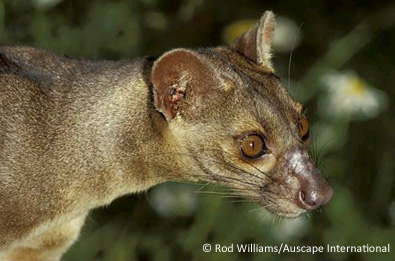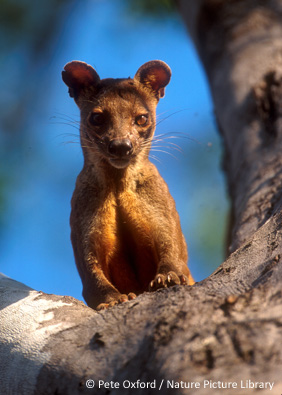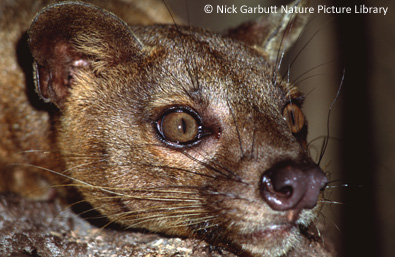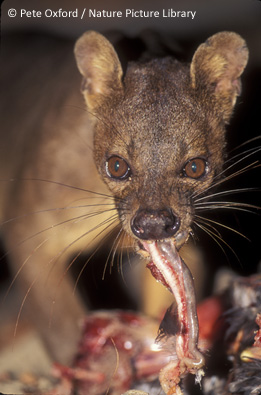The fossa (Cryptoprocta ferox) is a unique carnivore, endemic to Madagascar, is EDGE Mammal number 43, and is today’s IUCN Species of the Day.
There has been considerable dispute over where the fossa sits in the mammal evolutionary tree – it was originally classified as a felid due to its cat-like head and body shape (actually a result of convergent evolution), but was then moved to the family Viverridae which contains civets and genets. Finally, the fossa was assigned to the Eupleridae, a small group of Malagasy carnivores which also contains the falanouc.
The family Eupleridae contains just eight living species, thought to have evolved from a single ancestor which colonised Madagascar from the African mainland 18 – 24 million years ago.
Madagascar’s largest carnivore, the fossa is unusual-looking, rather like a cross between a dog and a cat. Active both during the day and at night, its diet consists mostly of small mammals and birds, but also includes reptiles, frogs and insects. It is a powerful predator, and has keen senses of vision, hearing and smell. An excellent climber, the fossa uses its long tail (almost the same length as its body) to provide balance when pursuing lemurs through the trees, which it climbs with its cat-like retractable claws.
Fossas have a very unusual mating system – a single female will exclusively occupy a site high in a tree, below which a number of males congregate. The males compete for mating rights and over the course of a week the female will mate with a number of different males. Once the original female has left, a new female will take over the site and, like her predecessor, mates with the males there. These ‘mating trees’ are used for many years.
Sadly the population of fossa is estimated to be fewer than 2,500, separated between several smaller groups, the largest of which probably has fewer than 400 fossa. The species’ forest habitat continues to be lost and fragmented, largely as a result of conversion of forest to agricultural land, and from logging, and fossa are also killed as a pest because they sometimes prey on domestic fowl.
A captive breeding programme has been established for the fossa – check out some brilliant footage of young fossa here – but protection of large, in-tact forest habitat is still required to guarantee the future of this wonderful creature.
The EDGE of Existence works to raise awareness and implement conservation actions for unusual threatened species that are overlooked by existing conservation initiatives.
To help conserve these forgotten species, please donate here.



